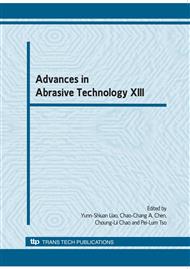p.696
p.701
p.707
p.713
p.719
p.726
p.732
p.738
p.744
Study of AE Signal for Tool Wear Monitoring in Micro Milling Based on LVQ Algorithm
Abstract:
The Acoustic Emission signal was studied in this report for tool wear monitoring in micro milling. An experiment was conducted first to collect the AE signal generated from the workpiece during cutting process for characteristic analysis, training the system model and finally testing the system performance. In the system development, Acoustic Emission (AE) signals were first transformed to the frequency domain with different feature bandwidth, and then the Learning Vector Quantization (LVQ) algorithms was adopted for classifying the tool wear condition based on the generated AE spectral features. The results show that the frequency domain signal provides the better characteristics for monitoring tool wear condition than the time domain signal. In considering the capability of the AE signal combined with LVQ algorithms, the sharp tool condition can be detected successfully. At the same time, 80% to 95% of the classification rate can be obtained in this study for the worn tool test. Moreover, the increase of the feature bandwidth improved the classification rate for the worn tool case and 95% of classification rate for the case with 10 kHz feature bandwidth.
Info:
Periodical:
Pages:
719-725
Citation:
Online since:
August 2010
Authors:
Price:
Сopyright:
© 2010 Trans Tech Publications Ltd. All Rights Reserved
Share:
Citation:


